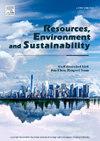Wood-derived topsoil cover positively influences the diversity and activity of tomato plant rhizobacteria
IF 12.4
Q1 ENVIRONMENTAL SCIENCES
引用次数: 0
Abstract
Worsening water shortages due to climate change have underscored the need for sustainable agricultural practices, including mulching, to restore soil moisture and health. Environmental concerns associated with plastic mulching materials in agriculture have prompted the adoption of biodegradable alternatives. Topsoil cover (TSC), developed through the valorization of wood industry by-products and xanthan gum, offers a sustainable solution. Indigenous microbiomes, predominantly Proteobacteria (e.g., Pseudomonas spp.), Firmicutes (e.g., Staphylococcus spp.), and Aspergillus spp., can biodegrade TSC under controlled condition. Germination tests confirm its effectiveness in weed control. A greenhouse experiment using tomato (Solanum lycopersicum) demonstrated that TSC enhances shoot and root length by 50 and 100%–160% and overall biomass by 30%–50%, without altering rhizosphere soil physicochemical properties or microbial community structure. Additionally, the reversible effect of TSC can enhance the early soil nitrogen pool by 20% through microbial interactions. It also increases soil microbial metabolic diversity, highlighting its potential for agricultural use. Our findings establish TSC as an innovative product that closes the loop on timber industry waste while enhancing soil fertility, promoting plant health, and enabling medium-term carbon storage in wood.

木源表层土壤覆盖对番茄根瘤菌的多样性和活性有积极影响
气候变化造成的日益严重的水资源短缺突出表明,需要采用可持续的农业做法,包括覆盖,以恢复土壤水分和健康。农业中与塑料覆盖材料有关的环境问题促使人们采用可生物降解的替代品。表层土壤覆盖物(TSC)是通过木材工业副产品和黄原胶的增值而开发的,提供了一种可持续的解决方案。本地微生物群,主要是变形菌门(如假单胞菌)、厚壁菌门(如葡萄球菌)和曲霉,可以在受控条件下生物降解TSC。发芽试验证实了其控制杂草的有效性。温室试验表明,在不改变根际土壤理化性质和微生物群落结构的情况下,TSC可使番茄(Solanum lycopersicum)的茎长和根长分别增加50%和100% ~ 160%,总生物量增加30% ~ 50%。此外,TSC的可逆效应可以通过微生物相互作用使早期土壤氮库增加20%。它还增加了土壤微生物代谢的多样性,突出了其农业利用的潜力。我们的研究结果表明,TSC是一种创新产品,可以在提高土壤肥力、促进植物健康和实现木材中期碳储存的同时,完成木材工业废物的循环。
本文章由计算机程序翻译,如有差异,请以英文原文为准。
求助全文
约1分钟内获得全文
求助全文
来源期刊

Resources Environment and Sustainability
Environmental Science-Environmental Science (miscellaneous)
CiteScore
15.10
自引率
0.00%
发文量
41
审稿时长
33 days
 求助内容:
求助内容: 应助结果提醒方式:
应助结果提醒方式:


